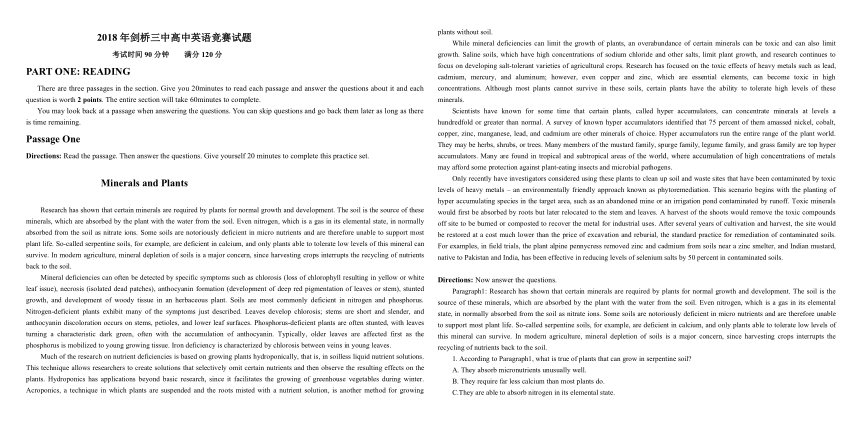
2018年剑桥三中高中英语竞赛试题 考试时间90分钟 满分120分 PART ONE: READING There are three passages in the section. Give you 20minutes to read each passage and answer the questions about it and each question is worth 2 points. The entire section will take 60minutes to complete. You may look back at a passage when answering the questions. You can skip questions and go back them later as long as there is time remaining. Passage One Directions: Read the passage. Then answer the questions. Give yourself 20 minutes to complete this practice set. Minerals and Plants Research has shown that certain minerals are required by plants for normal growth and development. The soil is the source of these minerals, which are absorbed by the plant with the water from the soil. Even nitrogen, which is a gas in its elemental state, in normally absorbed from the soil as nitrate ions. Some soils are notoriously deficient in micro nutrients and are therefore unable to support most plant life. So-called serpentine soils, for example, are deficient in calcium, and only plants able to tolerate low levels of this mineral can survive. In modern agriculture, mineral depletion of soils is a major concern, since harvesting crops interrupts the recycling of nutrients back to the soil. Mineral deficiencies can often be detected by specific symptoms such as chlorosis (loss of chlorophyll resulting in yellow or white leaf issue), necrosis (isolated dead patches), anthocyanin formation (development of deep red pigmentation of leaves or stem), stunted growth, and development of woody tissue in an herbaceous plant. Soils are most commonly deficient in nitrogen and phosphorus. Nitrogen-deficient plants exhibit many of the symptoms just described. Leaves develop chlorosis; stems are short and slender, and anthocyanin discoloration occurs on stems, petioles, and lower leaf surfaces. Phosphorus-deficient plants are often stunted, with leaves turning a characteristic dark green, often with the accumulation of anthocyanin. Typically, older leaves are affected first as the phosphorus is mobilized to young growing tissue. Iron deficiency is characterized by chlorosis between veins in young leaves. Much of the research on nutrient deficiencies is based on growing plants hydroponically, that is, in soilless liquid nutrient solutions. This technique allows researchers to create solutions that selectively omit certain nutrients and then observe the resulting effects on the plants. Hydroponics has applications beyond basic research, since it facilitates the growing of greenhouse vegetables during winter. Acroponics, a technique in which plants are suspended and the roots misted with a nutrient solution, is another method for growing plants without soil. While mineral deficiencies can limit the growth of plants, an overabundance of certain minerals can be toxic and can also limit growth. Saline soils, which have high concentrations of sodium chloride and other salts, limit plant growth, and researc ... ...
~~ 您好,已阅读到文档的结尾了 ~~

